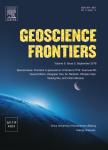Paleozoic post-collisional magmatism and high-temperature granulite-facies metamorphism coupling with lithospheric delamination of the East Kunlun Orogenic Belt,NW China
Paleozoic post-collisional magmatism and high-temperature granulite-facies metamorphism coupling with lithospheric delamination of the East Kunlun Orogenic Belt, NW China作者机构:College of Earth Science and EngineeringShandong University of Science and TechnologyQingdao 266590China Key Laboratory of Marine Geology and EnvironmentInstitute of OceanologyChinese Academy of SciencesQingdao 266071China State Key Laboratory of Nuclear Resources and EnvironmentEast China University of TechnologyNanchang 330013China College of OceanographyHohai UniversityNanjing 210098China Key Lab of Submarine Geosciences and Prospecting TechniquesMOEInstitute for Advanced Ocean StudyCollege of Marine GeosciencesOcean University of ChinaQingdao 266100China
出 版 物:《Geoscience Frontiers》 (地学前缘(英文版))
年 卷 期:2022年第13卷第1期
页 面:96-113页
核心收录:
学科分类:070902[理学-地球化学] 070903[理学-古生物学与地层学(含:古人类学)] 0709[理学-地质学] 070901[理学-矿物学、岩石学、矿床学] 07[理学]
基 金:supported by the Fundamental Research Funds for the Central Universities(No.2019B00414) Open Fund of the Key Laboratory of Marine Geology and Environment Chinese Academy of Sciences(No.MGE2020KG03) the PHD early development program of East China University of Technology(No.DHBK2018035)
主 题:East Kunlun orogenic belt Post-collisional extensional collapse Magmatism High-temperature metamorphism Crust-mantle interaction
摘 要:Lithosphere extension and upwelling of asthenosphere at post-collisional stage of an orogenic cycle generally induce diverse magmatism and/or associated high-temperature metamorphism. Nevertheless, the intimate coexistence of post-collisional magmatic activity and high-temperature metamorphism is *** this contribution, a lithological assemblage composing of diverse magmatic rocks deriving from distinct magma sources and coeval high-temperature metamorphism was identified in eastern ***, ages, mineral chemistry and whole-rock geochemistry demonstrated that those intimately coexistent diverse rocks were genetically related to post-collisional extension. The garnet-bearing mafic granulites in Jinshuikou area interior of the East Kunlun Orogenic Belt are mainly composed of garnet,orthopyroxene, and plagioclase, with peak metamorphic P–T conditions of ~ 701–756 ℃and 5.6–7.0 kbar,representing a granulite-facies metamorphism at 409.7 ± 1.7 Ma. The diverse contemporaneous magmatic rocks including hornblendites, gabbros and granites yield zircon U–Pb ages of 408.6 ± 2.5 Ma,413.4 ± 4.6 Ma, and 387–407 Ma, respectively. The hornblendites show N-MORB-like REE patterns with(La/Sm)Nvalues of 0.85–0.94. They have positive zircon εHf(t) values of 0.1–4.9 and whole-rock εNd(t) values of 3.9–4.7 but relatively high(^(87)Sr/^(86)Sr)_(i)values of 0.7081 to 0.7088. These features demonstrate that the hornblendites derived from a depleted asthenospheric mantle source with minor continental crustal materials in source. As for the gabbros, they exhibit arc-like elemental signatures, low zircon εHf(t) values(-4.3 to 2.5) and variable whole-rock εNd(t) values(-4.9 to 1.2) as well as high(^(87)Sr/86 Sr)ivalues(0.7068 to 0.7126), arguing for that they were originated from partial melting of heterogeneous lithospheric mantle anteriorly metasomatized by subducted-sediment released melts. Geochemistry of the granites defines their strongly peraluminous S-type signatures. Zircon



